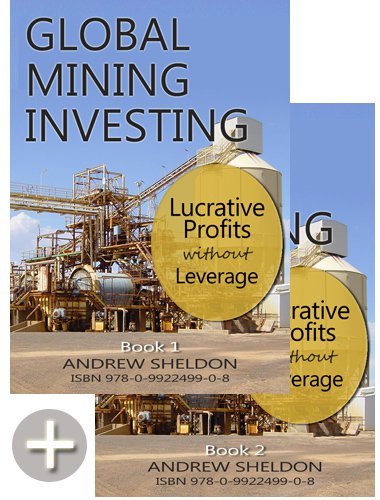
 Global Mining Investing $69.95, 2 Volume e-Book Set. Buy here.
Global Mining Investing $69.95, 2 Volume e-Book Set. Buy here.Author, Andrew Sheldon
Global Mining Investing is a reference eBook to teach investors how to think and act as investors with a underlying theme of managing risk. The book touches on a huge amount of content which heavily relies on knowledge that can only be obtained through experience...The text was engaging, as I knew the valuable outcome was to be a better thinker and investor.
While some books (such as Coulson’s An Insider’s Guide to the Mining Sector) focus on one particular commodity this book (Global Mining Investing) attempts (and does well) to cover all types of mining and commodities.
Global Mining Investing - see store
Thursday, December 01, 2011
The gold price set to rally in coming months

Friday, January 02, 2009
LME commodities likely to rally - except copper





I tend to think that all the other commodities have reached their lows, and so in the New Year rally, they will present good trading opportunities, particularly as I would expect them to be supported by a weaker USD. I will demonstrate as much on my forex blog.
-----------------------------------------------
Andrew Sheldon www.sheldonthinks.com
Sunday, September 07, 2008
Zinc prices support at $1450/tonne
 Zinc prices have fallen from a peak of over $4500/tonne to around $1800/tonne. You might wonder whether they have any further to fall. I believe they will at some point fall back to the $1450/tonne support. This level was an important resistance during the ascension of zince prices. The weaker economic outlook paints an unattractive outlook for zinc, but there will be a recovery in zinc demand with a resumption of building demand in the medium to long term.
Zinc prices have fallen from a peak of over $4500/tonne to around $1800/tonne. You might wonder whether they have any further to fall. I believe they will at some point fall back to the $1450/tonne support. This level was an important resistance during the ascension of zince prices. The weaker economic outlook paints an unattractive outlook for zinc, but there will be a recovery in zinc demand with a resumption of building demand in the medium to long term.----------------------------------------------
Andrew Sheldon www.sheldonthinks.com
Monday, January 07, 2008
Base Metals surprisingly strong
So is the sell off in base metal miners and emerging producers justified? I think it depends on the market. There are some strong factors in base metals favour:
1. Demand for metals in China remains strong. I believe Chinese demand will not remain strong. Historically I have found the Chinese traders and producers to be poor market analysts. They are sooo anti-conceptual. Demand has been strong for so long, so they believe it will be strong tomorrow. They would rather be wrong with everyone else than right alone. Chinese traders will be the last to recognise that the market is turning. That augers well for markets in the short term.
2. Weaker markets has a benign impact on domestic commodity markets. If you are a Canadian or Australian investor, you might be miffed by the fall in commodity based mining stocks. Miffed because metal prices remain strong, so why are mining equities being sold off with reckless abandon. The reason is that international investors are preparing for a slump in commodities (apart from gold). Whilst a falling $AUS or $CAN will boost or offset the fallin USD prices of commodities for domestic investors, the international investors will loose on the exchange rate. Expect those foreigners to re-enter the market at lower prices. Of course it makes sense for local (Australian & Canadian) investors to abandon mining stocks if the foreigners are going to, but they should also be ready to buy back in. The trick is to find the turning point in the $A. See my forex blog. So whilst base metals have fallen off slightly (15%), so has the Australian dollar, so producers are actually doing rather well, unless they have entered into some rather unfortunate hedging positions.
3. Tight supply. There is of course a concern in the markets that a slide in global economic activity will undermine demand for metals, and that should not be ignored. But there is also considerable tightness in equipment, plant and consumables supplies that has actually prevented an expansion of metal supply capacity. The implication is that prices might not adjust as much as expected. Having said that, prices are high in part because of that tightness, so any relief will be bad for prices. But that need not be true for all markets. A number of projects have not proceeded because they were out-bid for plant by bigger projects controlled by bigger companies. The iron ore, bauxite miners have got their ball mills before a small gold miner. So supply has been curtailed in some commodities more than others.
Tuesday, December 11, 2007
Base metal prices resilient
I would like to think that its a sign of incredible resilience in the global economy, but I dont think so, or at least its not the whole story. I think its a shortage of metal, or more specifically delays and difficulties commissioning new mine capacity, combined with the odd strike, as mine workers attempt to benefit from some of the high metal prices. There is a huge shortage of semi-autogenous grinding (mills), tyres and a range of other consumables. Its evident that these shortages are delaying projects, and even hindering established projects. So whilst the global economy might we softening, there is little relief for commodity buyers. The reason I suspect this is the case is because metal stockpiles seem to be falling. Take a look at stockpiles at the LME and COMEX exchanges. Nickel is rising to medium term highs, but zinc stockpiles have been falling since Oct'07, lead stockpiles started falling this week, copper on the COMEX has falling stockpiles since Oct'07, and flat on the London Metals Exchange lately. Aluminium stockpiles have stabilised.
At the same time most of the commodity producing currencies have experienced something of a sell-off. eg. The AUD has fallen from 93c to 87c against the USD. So it all looks good for commodity producers. So I like Matrix Metals, given that its planning to expand output significantly.
Wednesday, September 26, 2007
Source of Base Metal Charts
The historical charts can be accessed at:
1. Copper: See www.kitcometals.com/charts/copper_historical.html
2. Zinc: See www.kitcometals.com/charts/zinc_historical.html
3. Nickel: www.kitcometals.com/charts/nickel_historical.html
4. Lead: www.kitcometals.com/charts/lead_historical.html
5. Aluminium: See www.kitcometals.com/charts/aluminum_historical.html
6. Tin: See ???
In the precious metals we have
7. Gold: See www.kitco.com/charts/techcharts_gold.html
8. Silver: See www.kitco.com/charts/techcharts_silver.html
9. Palladium: See www.kitco.com/charts/techcharts_palladium.html
10. Platinum: See www.kitco.com/charts/techcharts_platinum.html
11. Rhodium: See www.kitco.com/charts/historicalrhodium.html
These are the traded metals where there is a high level of price discovery or disclosure. There are of course alot of other where price information is not so transparent because these metals prices are concealed by confidential commercial agreements between producers and end users. The reason for this is that these markets are illiquid. Another problem is that the metals are often sold as ores or metal concentrates with widely variable concentrations, as well as price bonuses (for precious by-products) and penalties (for deleterious contaminants). For this reason its difficult to reach a standard price for these commodities because every refinery has a different pricing policy to achieve competitive advantage. These metals include:
12. Zircon:
13: Niobium:
14. Tantalum: See www.metalprices.com/FreeSite/Charts/tantalite_charts.html?weight=lb (before 2006) and http://metalsplace.com/prices/?a=14&grt=6 since.
15. Molybdenum: See www.adanacmoly.com/adanac_stock.php
16. Manganese: See www.metalprices.com/FreeSite/Charts/mn_ferro_charts.html?weight=lb (before 2006)
17. Cobalt: See ??
18. Magnesium: See http://metalsplace.com/prices/
19. Chrome: See ??
20. Antimony: See ??
21: Bismuth: See ??
22. Tungsten: See http://metalsplace.com/prices/?a=4&grt=5
23. Mercury: See ??
24. Vanadium: See ??
25. Cadmium: see www.asianmetal.com/Metal_News/index_product63_en.asp or http://metalsplace.com/prices/?a=15&grt=6
26. Iron ore: See http://metalsplace.com/prices/
No other metal not listed here is sold as a discrete commodity because they dont occur in isolation. Even some of the commodities above are seldom mined as a discrete commodity. eg. Cobalt is usually a by-product of nickel mining, bismuth is often a by-product of tin mining, antimony is often associated with gold. These metal combinations might simply be liberated by physical crushing, but often they require more expensive chemical separation processes that directly impact on the value of ores, thus making price determination less transparent.
Finally we have the energy-based commodities:
25. Petroleum:
26. Natural Gas:
27. Uranium (yellowcake): See www.uxc.com/review/uxc_g_price.html or in constant dollar terms www.uxc.com/review/uxc_g_hist-price.html
28. Thorium: See http://minerals.usgs.gov/minerals/pubs/metal_prices/
Otherwise you can perform price queries at this site: www.metalprices.com/freesite/historical/price-query.asp. See the US Geological Survey for more more info on commodities: http://minerals.usgs.gov/minerals/pubs/metal_prices and www.crbtrader.com/fund/articles/default.asp. Here are a few other places for metal price charts - http://www.mineralstox.com/.
 Global Mining Investing $69.95, 2 Volume e-Book Set.
Global Mining Investing $69.95, 2 Volume e-Book Set.Author, Andrew Sheldon
Global Mining Investing is a reference eBook to teach investors how to think and act as investors with a underlying theme of managing risk. The book touches on a huge amount of content which heavily relies on knowledge that can only be obtained through experience...The text was engaging, as I knew the valuable outcome was to be a better thinker and investor.
While some books (such as Coulson’s An Insider’s Guide to the Mining Sector) focus on one particular commodity this book (Global Mining Investing) attempts (and does well) to cover all types of mining and commodities.
Global Mining Investing - see store
Japan Foreclosed Property 2015-2016 - Buy this 5th edition report!
You can view foreclosed properties listed for as little as $US10,000 in Japan thanks to depopulation and a culture that is geared towards working for the state. I bought foreclosed properties in Japan and now I reveal all in our expanded 350+page report. The information you need to know, strategies to apply, where to get help, and the tools to use. We even help you avoid the tsunami and nuclear risks since I was a geologist/mining finance analyst in a past life. Check out the "feedback" in our blog for stories of success by customers of our previous reports.
Download Table of Contents here.






![[Most Recent Quotes from www.kitco.com]](http://www.kitconet.com/charts/metals/gold/t24_au_en_usoz_2.gif)
![[Most Recent Quotes from www.kitco.com]](http://www.kitconet.com/charts/metals/silver/t24_ag_en_usoz_2.gif)
![[Most Recent Quotes from www.kitco.com]](http://www.kitconet.com/charts/metals/platinum/t24_pt_en_uskg_2.gif)
![[Most Recent Quotes from www.kitco.com]](http://www.kitconet.com/charts/metals/palladium/t24_pd_en_usoz_2.gif)